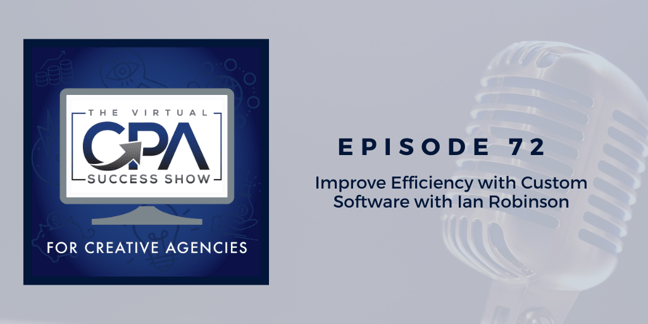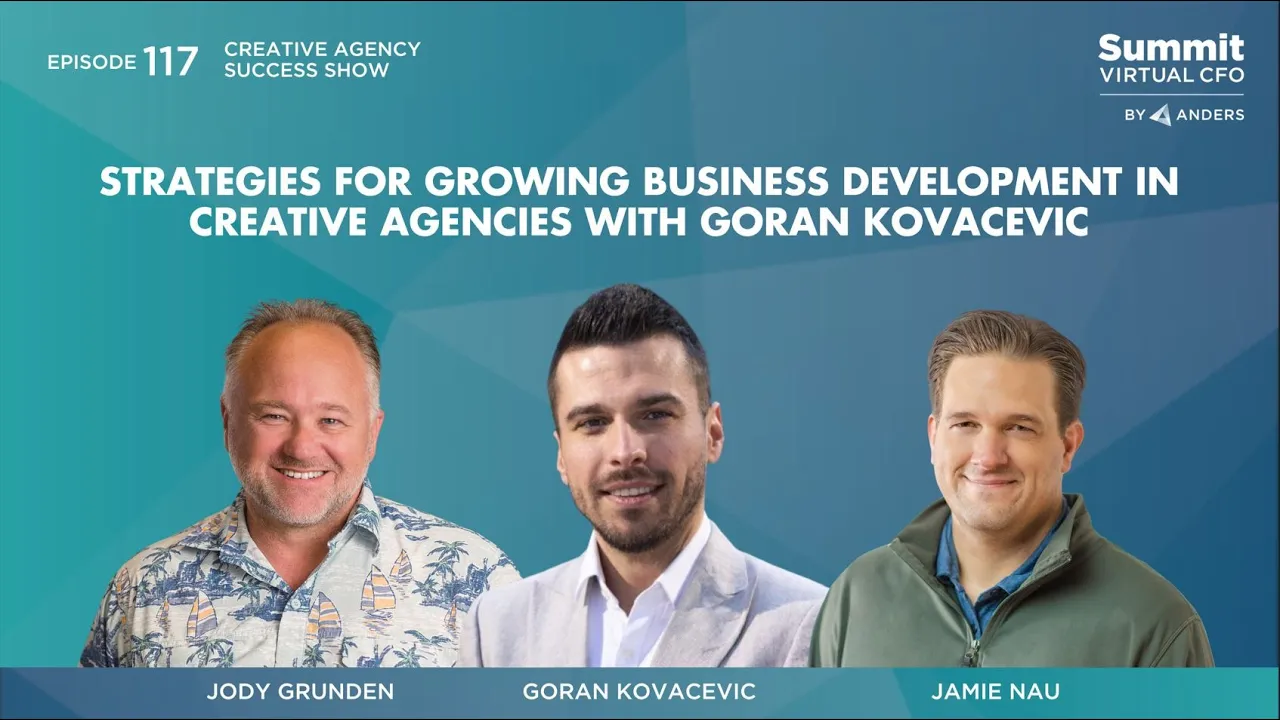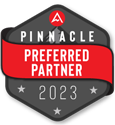The Virtual CPA Success Show: Episode 72
In this episode, Jamie Nau, our host and Summit CPA's Director of Virtual CFO, and Jody Grunden, Partner at Anders CPAs + Advisors, talk with Ian Robinson, Founder and President of Enliven, a software company that builds custom software platforms to unlock sustainable growth for business. If you’re a business owner in need of updating or customizing your company’s software, this episode is for you.
[00:00:20] Jamie Nau: Hello, everybody. Welcome to today's episode. I'm really excited for a great topic. We have a special guest here Ian Robinson from Enliven. I'll let him tell you more about his company and more about him. But let's start with that intro. Ian, welcome to the show.
[00:00:32] Ian Robinson: Thank you. Thanks, Jamie. Good to be here. I’m the founder and president of Enliven in St. Louis, Missouri, and we're actually weird in that we're all in the same city, and also we work remotely. We’re a custom software shop, and we're really focused on as much as we can be the professional services space. Building software platforms for internal teams generally to deliver expert services. We're celebrating 10 years this year.
[00:01:10] Jamie Nau: Oh, great. Congratulations. As you can hear, we’re joined by Jody as well.
[00:01:13] Jody Grunden: So, you're headquartered in St. Louis? And you are also remote. So, you've got a fully remote team, or you've got a partially remote team, or how does your team work?
[00:01:25] Ian Robinson: We're fully remote.
[00:01:28] Jody Grunden: You can handle any issues anywhere in the United States or abroad? So, you're not limited to a geographic location then? That's cool. When did you go remote by chance? Just kind of curious, getting some background information here.
[00:01:41] Ian Robinson: My non-surprising answer is somewhere around May of 2020. Yeah, and we've always kind of had the flexibility of working hybrid or working remote even when we had an office downtown. But I think just personality wise, we all like to get together and collaborate in person.
[00:02:10] Jamie Nau: So, do you still do those meetups as a team to collaborate and where do you do those?
[00:02:13] Ian Robinson: We have a coworking space that we meet up at sometimes, but, more often than not, we're a fairly small team, so the main three of us will meet up at a coffee shop or the park; we all happen to live in the same neighborhood.
[00:02:33] Jody Grunden: Oh wow. That's awesome. We literally just got back from St. Louis. We had our firm retreat in St. Louis. We have one every six months, and this one was at the St. Louis headquarters. So, kind of piggybacking off your comment, we are part of Anders CPA Group out of St. Louis, and they've got about 300 folks right there at the office.
[00:02:55] And then we've got another 70ish that are fully remote. And so, we became a division of Anders in April of this year. This was the first time that a lot of our team members got a chance to even pop headquarters there. It was a great experience for everybody. St. Louis is a great city. We had a lot of fun and did a lot of cool stuff. We hung out down there by the ballpark area.
[00:03:23] Jamie Nau: And both times I've been to St. Louis, I've been to the Tin Roof bar, so I'm hoping there's other bars there, too.
[00:03:29] Ian Robinson: We have others. There are plenty.
[00:03:35] Jamie Nau: Good, good music there. It’s the first time we went there was karaoke. And did you end up getting on the stage at that time?
[00:03:40] Jody Grunden: Yes, I did. It was an experience. You forgot, obviously.
[00:03:44] Jamie Nau: I did forget. Well, I've done karaoke with you so many times that it's hard to remember which time you've done it.
[00:03:54] Ian Robinson: That's cool.
[00:03:57] Jody Grunden: So, you kind of gave a broad summary of what you do. Me, as a listener and as someone who's listening to you explain it, it sounds like my imagination's going a lot of different directions. So, do you want to give one direction of a solution or one example of a solution you provided that might give context to our listeners?
[00:04:16] Ian Robinson: Yeah. I could give a lot of different examples, from the healthcare space or construction; they all have a lot in common.
[00:04:29] But we're usually replacing existing systems of some sort and kind of modernizing things. So, it’s either a digital transformation or digital re-transformation, something along those lines. So, one example from the construction space is a company we worked for here in St. Louis called Pain Crest Electric.
[00:04:52] We rebuilt a system that they had for managing electrical installations. They did giant light projects last year. Tons of electricians in a powerhouse or data centers, you know, building new data centers for very large companies that we've all heard ofAnd what we do is come in and really get to know their team and their processes and try and turn their kind of proprietary system and approach into a software product.
[00:05:24] It's a software product. Unlike a SaaS product, it's meant to exist in one environment, okay? But in all others, all the other characteristics are pretty much the same. It's just very personalized. And what I've really come to enjoy about these types of projects is seeing them last and thrive in these single environments over time.
[00:05:48] I think one of the issues that a lot of us in the software world have seen is just churn with systems–doing a system, redoing a system. So we are very much into creating stuff that lasts about as long as it can.
[00:06:10] We have stuff that's turning 10 this year that we launched 10 years ago that is still being adapted and growing with the companies that we've worked for,
[00:06:25] Jody Grunden: So the software, is it mostly like a process software? When you go into an ideal client, are they looking to improve a process or certain area?
[00:06:38] Ian Robinson: Yeah, there's a lot of process, project management and operations. So it's always data, workflow, reporting, and then tools over that data, different role-based collaboration, and having a variety of features for everybody on the team.
[00:06:57] In the electrical contracting example, there's a foreman, there's field workers, there's engineers and project managers, there are folks that are doing administrative work, and they all have a different view on the same thing, right? But this exists as the source of truth for all of their project data.
[00:07:19] So who did what and when, who needs to do what and when–really just generally how things are going? An example I can think of in healthcare is regulatory compliance, auditing for 340B program, if there are any pharmacy people out there.
[00:07:41] And same stuff, right? Role based collaboration, workflow, really building these custom tools around a bunch of data and being the source of truth for their process, collaboration, and who needs to do what and when.
[00:08:00] Jamie Nau: And so earlier you kind of mentioned the long life, so you mentioned 10 years.
[00:08:04] And so how much maintenance do you usually have to provide in order to keep those things going?
[00:08:09] Ian Robinson: Yeah. If we solve it well up front, it's relatively small. When I talk with clients now, my recommendation is budgeting 10 to 20% of the initial budget for year over year, kind of just health and growth.
[00:08:31] That's not really including big chunks of new things. It's more just the smaller kind of paying into the longevity bucket over time.
[00:08:43] Jamie Nau: I haven't even been at Summit for 10 years, and I can't tell you how many different technologies we've gone through in that amount of time.
[00:08:49] So 10 years, that's something to hang your hat on because if you can keep a technology in one company for 10 years, that's pretty impressive.
[00:08:56] Ian Robinson: Yeah. And, where it's kind of coincidence because I did a computer science degree way back when and they looked at me and said, Do you want to do the Java track or the.net track?
[00:09:06] Or Microsoft World? I was like, I don't know .net. So I've lived in the Microsoft world ever since. There's been a lot of ups and downs, but one thing that I'll have to say is, there's a lot of longevity there. So in the enterprise software world, you can upgrade and keep all of the Microsoft stuff going, and we're always building stuff for the web, too.
[00:09:30] And that predates my computer science degree. I've always been building things for the web. And the web is timeless in a way that a lot of other technologies aren't, even though it is changing over time as well.
[00:09:47] Jody Grunden: Can you walk me through how a typical engagement would work?
[00:09:49] So if we were to hire you to maybe help us, how would that work from start to finish?
[00:09:58] Ian Robinson: So the first thing that we'd do after sorting out if we would be a good fit, is something called a framing engagement, which is really our kind of hybrid strategy and discovery phase.
[00:10:11] We really just frame out all the goals and sort out some of the things that are most interesting to pull out. This is really just keeping track of and discovering what everybody's actually doing. So not what they say they need, but what they're actually doing and pulling assets as we can and trying to put together our own picture independently, not necessarily what everybody's saying.
Because a lot of times, folks are really thinking about their single perspective or their pet concern, which is interesting and important, but it's not necessarily a piece of something that's going to be relevant for years to come.
[00:11:08] So we're trying to, in that framing phase, discover what it is that's been true, what's the spirit of this process, this system, that you've developed? Why is it working for people? Why are we here and what's been true about that for a while and what's likely to be true for a while longer?
[00:11:30] And we're just trying to model that, so after we get through the framing phase, the framing phase yields kind of a platform build.The build is kind of boring foundations a lot of the times because it needs to really model all those things about your system and your worldview, your culture, you know, use all the right words so that it is very accessible to everybody.
[00:11:58] It can be kind of boring and anti-climactic sometimes. That, but it's really important to do that stuff first, and really look at it as a foundation upon which will build and adapt toward all the more speculative stuff. I'd say from there, it's really getting it out the door and up and running with everybody using it.
[00:12:27] We look at it as health and growth from there. So there's some amount of proactive maintenance. There's some amount of reactive support, and then there's more strategic kind of planning and new features that get bolted on over time. But we're working to not work backwards from that foundation.
[00:12:50] We've set up a system that will be durable over time, ideally.
[00:13:02] Jody Grunden: You made a comment about listening to the client's concerns and that those may or may not be the real concerns. That kind of struck me a little bit because they may be looking to patch a hole, when really, they should be building a bigger hole, or putting the hole somewhere else, that type of thing. Can you give me some examples of that?
[00:13:27] Ian Robinson: A lot of times it can be wanting to go after a specific technology or a specific kind of use case. But we kind of uncover that in the framing phase–what's more important.
[00:14:15] Jamie Nau: Let me ask a follow-up question then. So, what I've seen with this a couple times is when I talked to clients that have a similar experience, is that because you're coming in and you offer an alternative solution to the problem, as Jodi mentioned, they think they need to patch the hole, but they really need to make it bigger.
[00:14:31] Oftentimes, they'll turn you down and they'll say, ‘Oh no, we really want to patch that hole.’ And then, two, three, four years later, they're coming back to you being like, ‘Okay, you were right. We're ready to work with you now.’ So has that happened to you frequently?
[00:14:44] Ian Robinson: It has happened before. Where folks come back later. It's pretty strange. I think the reason this doesn't happen as much anymore is because when we get the buy-in on the framing phase, we've already made sure that it's a good fit, that they want to hear our recommendations. Right?
[00:15:04] They've seen us as somebody who can advise them and help them navigate. So they're open, and it's something that I've maybe intuitively or just kind of worked to say ‘no’ to people that aren't that aren't really open to that because, invariably, we're trying to figure out what problems to solve.
[00:15:30] We're not the folks that you wanna hire if you already have figured it all out. And actually, one example that I have is somebody called us in 2020 and he had figured out a massive kind of e-learning platform, and he had hundreds of mockups and just everything was done already, and he just needed somebody to make it.
[00:15:58] I don't understand the amount of time that it would've taken for us just to go through all of that stuff while trying to understand some of his core assumptions. He's not a software designer, so trying to work backwards from ‘Why are we even solving? What’s the problem in the first place? What is the point of this thing?’
So, it can be a little bit tricky when folks have the resources to commission a big work. Maybe they should be commissioning a much smaller work to start with.
[00:16:46] Jody Grunden: So you actually go through that and you identify that within the first phase. After the sales call’s closed and you're ready to go, the first phase you're diving in and you're uncovering, at that point, like you had mentioned, you might end up backing out of the engagement at that time versus, you going forward.
[00:17:04] Ian Robinson: Yeah.
[00:17:04] Jody Grunden: No one's gonna be happy at the end, you know, They're not gonna be happy. It's not gonna be a good ending no matter how you approached it then.
[00:17:12] Ian Robinson: I always worry about it, but it's always well-enough received. And everybody feels, or at least I feel, good about it afterwards. Maybe they'll feel good about it down the road if not right away.
[00:17:30] Jamie Nau: So, in my notes, I have, what I think is a really interesting, area that you work on that a lot of companies are thinking about right now, and that’s hiring. So can you give some examples or some ideas of how software can improve that onboarding, hiring phases of the company?
[00:17:43] Ian Robinson: The way that I like to think about that is, when we are building these platforms for internal work to be done, we're creating a digital work environment, or a big part of it at least, and that encompasses all the SaaS products that you buy, all the different things that everybody's using.
[00:18:08] We really like to go to those pieces that are core business operations. Again, project management and expert service delivery. And those pieces tend to bring out more of the culture and personality and industry expertise for a given company. And so when we are building these platforms, oftentimes, a secondary way that our clients look at it is,’Oh, this helps with recruiting and it helps with recruiting because it sends signals that we are taking care of, we respect our employees and we give them good tools.’
[00:18:49] So it can kind of look good from afar in that way. But then when employees actually get in the door, a lot of the challenges that I've seen in the past is people have systems and processes documented, and then they have them implemented somewhere and that thing that they're implementing them in was a SaaS product built for many businesses, right? So there's always a little bit of a gap between what we say we do and then how we actually do it. So one of my favorite parts that's very easy to take for granted is when we are building a software platform that's at the heart of service delivery, it's modeling their world and their vocabulary.
[00:19:39] It can kind of provide guidance and education for how the company works in a very hands-on and tactile way. And I say it's easy to take for granted because you show up and you're like, ‘Okay, I need to jump in on this project.’ And they add you to it and you get in there and things tend to make sense.
[00:20:00] Everything you're looking at in the software is what your coworkers are talking about. Right? In the same words, they don't see different words. Like we say it this way, but you have to click on a completely different button. And I mean, it sounds a little contrived, or I worry that it does, but think about how many buttons we're clicking on all day.
[00:20:21] Then think about all of the employees over the years in all of these different ways that we're just creating unnecessary overhead and unnecessary complexity. It's not necessarily the thing that gets us in the door or necessarily closes a sale, but I think one of the keys to things staying relevant over time is really taking that seriously; we're welcoming everybody into a home base of sorts for this area of the business.
[00:21:03] And so, It's not just some tools to get our work done, it's also kind of the source of truth for our process and guidance as well.
[00:21:16] Jody Grunden: So it sounds like people should, or healthy companies should always be looking for, what tools can we use to improve processes, to improve employee experience and improve customer experience?
[00:21:29] Because they all kind of go into each other; they all kind of flow. And I think when a person or an owner or a CEO of a company, thinks that they've got everything dialed in and everything's perfect, they may want to look back in the mirror a little bit because nothing's ever perfect.
[00:21:45] Ian Robinson: That's fair.
[00:21:47] Jody Grunden: How would I, as a CEO, go about that task? Is there a simple way that I could kind of look, look through my processes, my things, and say, ‘What’s a tool that you could create for us that would be hugely beneficial? How would I self access that?
[00:22:05] Ian Robinson: I think the biggest thing that I've found here is actually trying to gauge human emotion, right? So looking for pain and frustration is number one. It can be difficult because people normalize this; we expect to have to adapt ourselves to software because of course it's not gonna know what we want from it.
[00:22:36] Our thing is, well, it shouldn't always be that way. Maybe it should never be that way. And maybe we are really good at normalizing things that we shouldn't, but I think going through and actually looking for inefficiencies or extra overhead or mistakes and problems and doing a lot of sentiment analysis, to find out how people are actually feeling about it.
[00:23:09] The main thing that I'm focused on above and beyond kind of meeting the specific needs of the project is making sure that everybody's feeling good about things.
[00:23:24] Jamie Nau: So you come into a new client and you're trying to figure out those questions, like, how many people do you need to talk to on the team?
[00:23:29] And how do companies feel about it? Or, I'm gonna talk to these 30 people cause they're the largest users? Is that something they get excited about? Or they're like, Oh no, I'm not sure that I want you talking to all my employees to ask these questions.
[00:23:41] Ian Robinson: I've had both experiences. Some cultures are very open to finding problem areas and addressing it and other company cultures aren't. In fact, we've had our hand kind of slapped a little bit and had to reign it in because they don't wanna send signals that there are problems or that there could be problems.
[00:24:07] ‘We're just trying to make sure, we're just trying to check in, right? We're not looking for problems. We're just checking in with folks to see how things are going.’ So it depends, and we typically don't have to talk to a huge volume of people to get a good sense of it.
[00:24:28] Or even have to ask them, ‘how much do you hate this? Or how, you know, very direct questions about their feelings. Well, let's just talk about how you work. Go take me through your work day. What do you spend time on? What do you spend time on that feels kind of repetitive and if you could come up with another way to do that, that would be great.
[00:24:53] Generally when you really get down to it, the conversations are much softer and they're not too contentious.
[00:25:06] Jamie Nau: You're not just going into a room saying, Hey, lay it all on me. I wanna hear everything wrong with this system.
[00:25:11] And then the company comes back to the company like, Here's everything you're doing wrong, and here's how we're gonna fix it. Like, no one likes to hear that.
[00:25:18] Ian Robinson: Even when we do discover better ways of doing things and implement them, there's always this hurdle I think of, ‘well, I just change.’
[00:25:32] People don't want to make changes. And a lot of times, we've normalized using software that doesn't understand us and doesn't understand what we want out of it. So people have created great workarounds that they're very proud of and that could be hard to let go of. I worry about those things, but we've, in the end, not really had a problem with that either.
[00:25:57] Because once people realize they can let go of all that stuff and there's a better way, they're pretty quick to adopt it.
[00:26:05] Jamie Nau: We are right at time here, so, Ian, we end all of our shows with kind of your final thoughts. So this is your one last chance to tell all of our listeners what they should be thinking about after this podcast.
[00:26:16] So I'll let you go first and I'll let Jody wrap it up.
[00:26:19] Ian Robinson: Cool. Yeah. I had one thought that I have a wide variety of interests. I was reading through some architectural essay and there was a quote that struck me that I think adapts pretty well to my work, which is something along the lines of: the primary job of architecture and architects is to create a space that feels at least subconsciously reassuring.
[00:26:50] So the idea of, we've all been in a waiting room, which you're not meant to be in. You're meant to leave it so that space doesn't want you there. It's not necessarily very reassuring and welcoming. And I think in the software world, and we say at least subconsciously, because you don't have to hit people over the head with welcome signs.
[00:27:11] Right, it just has to feel like you're in the right place. ‘Oh, this is for me.’ And I think that may be a very subjective thing. I'm interested in stealing as much as I can from the discipline of architecture because they've made that objective in a lot of ways, too.
[00:27:32] And so that's a little journey that I'm on, but I think it would be good for us to all try to at least have a gauge of how reassuring a particular digital work environment is for ourselves because that stuff really adds up over time.
[00:27:51] Jody Grunden: Yeah, I a hundred percent agree. That was one of the big things that I love about our company is we're constantly looking for ways to improve processes, constantly looking for ways to improve technology. Always looking to better our people in all different ways.
And the combination of those three is really what makes automation so successful, what makes profitability so successful, and makes worker experience so enjoyable.
[00:28:18] Never get too attached to any particular process. Never get attached to any particular software because everything can and will be improved, especially with technology growing at the speed it is growing right now.
[00:28:39] I mean, The software that was the gold standard yesterday for your firm may not even be in existence tomorrow. You may have gone to something different. And that's the beauty of it. And that's the great thing of running a company. And I think if you're not bringing Enliven into your company to at least evaluate what you might be doing right and wrong, the worst case scenarios, they come in and they say, you know,
[00:29:02] ‘You guys are doing everything great. I wouldn't I wouldn't worry about it. Or in the worst case or in the best case scenario, they say, Hey, you can improve on things.’
And I say the best case because they're always looking for that improvement and bringing them in would be a huge benefit to find out if that process; what you've been doing is taking your team forever and they're frustrated every time they're using it.
[00:29:24] And then you find that there's a tool that can be developed to eliminate the process completely, that's a big benefit and a big kudos. So I love what you're doing. I think it's definitely needed in really just about every company out there. And I definitely enjoyed the conversation.
[00:29:44] Ian Robinson: Likewise. Thanks for having me.
[00:29:58] Jamie Nau: So thank you very much, Ian. And you as well, Jody. I thought that was a great conversation and look forward to talking to you guys again soon.

Share this podcast episode on Twitter:
The Virtual CPA Success Show for Creative Agencies 🎙️ by @SummitCPAGroup:
Episode 72 - Improve Efficiency with Custom Software with Ian Robinson 👉 https://ctt.ec/katcY+
.png?width=190&height=122&name=Summit-Virtual-CFO_color_rgb%20(1).png)














Leave a comment